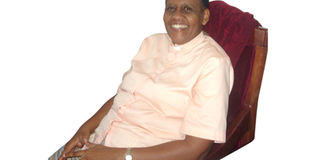Rev. Diana Nkesiga: Bringing femininity to the pulpit

The Rev. Diana in her office at All Saint's Cathedral in Nakasero where she serves as vicar since 2007. File Photo.
What you need to know:
Here is a woman who has held onto her female attributes despite her institution’s regulations. She brings the woman to the ministry in a more effective way than just ordination, writes Rebecca Rwakabukoza.
When the Rev. Diana Nkesiga returned to Uganda at the end of 2005, she was skeptical about the role she would play in the church as a female cleric. This was not a debate that was restricted to Uganda. She had faced similar challenges in Port Elizabeth, South Africa, where she had lived since leaving Uganda at the end of 1992, as a deacon. Women had been scholars in the church alongside men, as early as 1964.
The Rev. Diana, as she has come to be more commonly known, says they studied with the men and at the end of it all, the men were ordained as priests, while the women continued to work in the church as commissioned workers. “There is no real definition of a commissioned worker. They are more educated than lay readers, qualified to be ministers, but are not ordained,” she says.
Pregnant clergy
At the time she left, Rev. Diana was supposed to be priested, if everything had gone according to plan. She was on the ordination list one second and the next she was not. She jokingly says it must have been her pregnancy that disqualified her. At the time she was put on the list, no one was aware of her pregnancy and when her name disappeared from the list, she was visibly pregnant. She left the country and proceeded to cause quite an upheaval in South Africa, where her husband had been posted as a parish priest in a little town called Engcoba, as a pregnant pastor.
On one occasion, her husband was supposed to talk at an HIV/Aids rally but he collapsed from a bout of malaria for which he had failed to access proper medication. Filling in for the sick parish priest was his heavily pregnant wife. “I was eight months pregnant. It was on national TV... I did not know it was going to be televised,” she recounts.
The cloth
Her dress code is strikingly different. She recounts her horror at the attire back when she became a commission worker in 1989. “It was a blue dress and a funny hat.” She proceeds to describe an outfit that sounds like a cross between a school girl’s dress and a barmaid’s uniform.
An outfit she refused to wear but instead tailored a “skirt in the same shade of blue, a white blouse with a Chinese collar, a blue ribbon to tie around the shirt” that she combined with a blue borelo. As the bishop prayed over her, he did not notice because she, alongside others, wore a cassock over her attire. Until it was time for pictures. “I nervously removed it and the Bishop thought it was great,” she says. She would take the same action-first-discussion-later technique in South Africa to get out of the deacon outfit.
With another female deacon, she bought floral material. The Rev. Diana recounts; “I got a floral pink and the other priest bought a floral blue one. We had them tailored and walked onto a synod meeting dressed in our floral blouses. We walked upto the Bishop and simply said we were sorry we were late.” The Bishop approved of their outfits, and that was it.
Making the best of a situation
She describes her first months in South Africa as “frustrating” but maintains that God has plans because she got to spend time with her new born baby. At this point, as a female deacon, she was heavily excluded from the church ministry. She was told that it was okay to talk to the women, children and the youth if she wanted to. “I was okay with that. Women, children and youths make up the biggest percentage of the church congregation,” she narrates.
Always the active one, she started a nursery school on the church compound because she saw a need in what was then apartheid South Africa for an English-speaking Christian school. “I failed to get any funding for it so I used my sitting room.” The school that she called Stepping Stones later got support from the church and the government and is still functional as a fully fledged Christian school.
Rev. Diana made the most of the situation. After the end of apartheid, she ministered at the University of Port Elizabeth, where she says her congregation was “largely male” and she represented to them “the mother they did not have” through counselling. She presented a space in the church where they could talk about HIV/Aids, dating and relationships, family and other problems youth battle with.
Return to Uganda
When she was invited to return to Uganda to be ordained, it was rewarding. But when she was faced with the opportunity to minister to the church, she was not sure. “When I left, women were ornamental,” she notes. Rev. Diana, who is referred to by some of her youthful congregation as “Rev. D”, found a promising Uganda. There were more clergy women ordained in the Church. “There was more presence, more responsibilities and more respect. I also found the policy of a woman being vicar at All Saints’ Cathedral,” she says.
The Rev. speaks with a refined Welsh accent, which she says she picked up from her teachers at Nakasero Primary School in Kampala during the colonial days. An interview with her is delightful for more than her English.
She is aware of the effect of little things like clothes but even more so, she teaches us that we have to be proactive about things.




